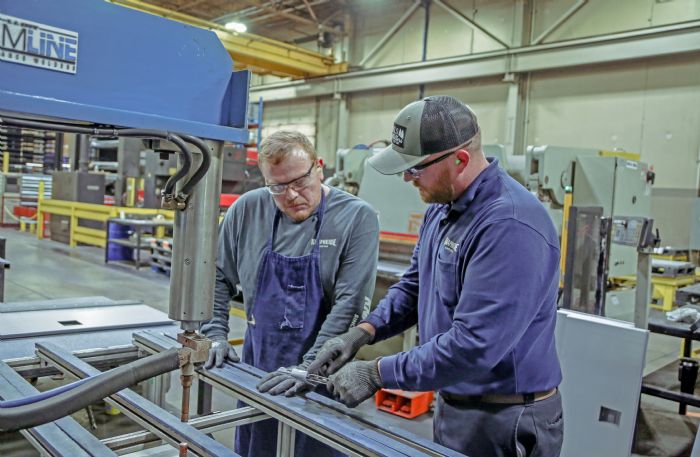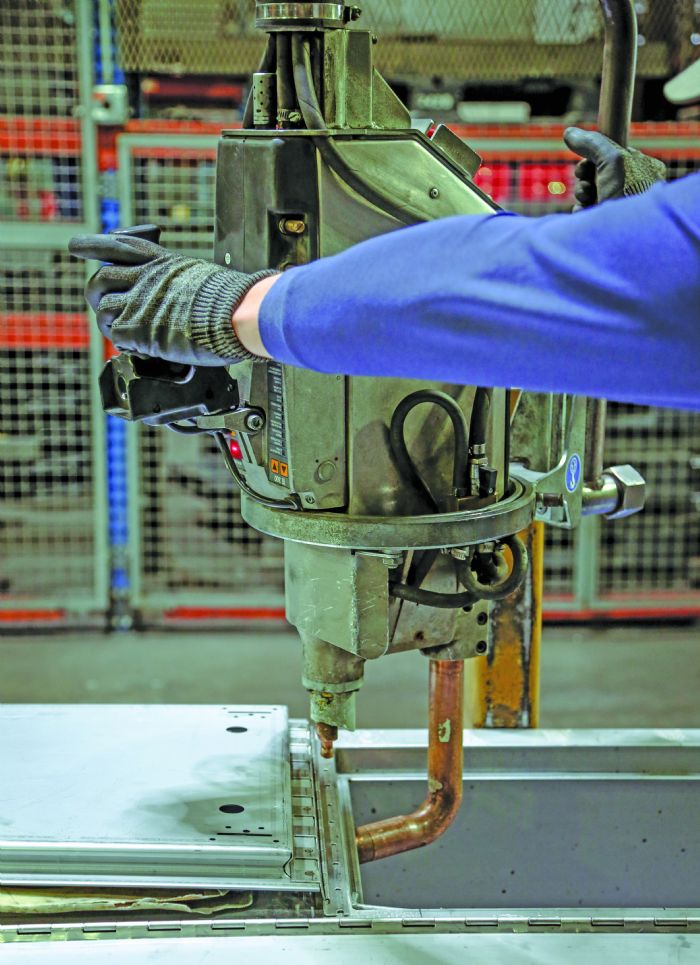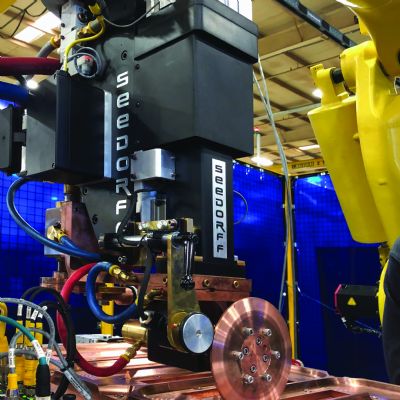The CRWT credential, co-developed by AWS and the Resistance Welding Manufacturing Alliance (RWMA), a standing AWS committee, establishes a new standard for the qualification of resistance welding (RW) personnel.
“CRWT credentialing sets us apart,” says Sparrow. “It shows that we understand the technical background. We are able to share knowledge to make our welding team successful, our operators successful and the company successful. We verifiably have better processes and people for consistently producing quality parts.”
Core Competence
Knapheide employs some 900 people on the shop floor, 70 percent of who perform welding operations across three shifts using inverter-based gas-metal-arc-welding (GMAW) power sources, stationary RW machines and six hand-held RW guns.
The company established an internal welding program in 2001 to train employees on the science of welding, so they could better understand problems and how to solve them. As senior personnel continue to retire, the original 24-hr. training program has expanded to two full weeks of training. Given today’s hiring challenges, training becomes more essential and is in fact mandatory for all potential operators, regardless of extent of welding experience. Prospects are hired for their promising work ethic and team-oriented attitude, but they usually need to learn RW mechanical skills and related technology.
“About 30 percent of our training is classroom-driven, with the balance hands-on,” says Murry. “At the end of the training program, the student-employees develop and build actual products off of the assembly line with no pressure to meet specific productivity goals. That way, when they get to the shop floor we know they have the required skillset. We supply everything trainees needs except for their steel-toed boots.”
Meeting the Need
After implementing a successful GMAW training program, Murry earned responsibility for RW training, which had been managed by the manufacturing department. After spending considerable time exploring available training curricula, Murry realized that nothing met Knapheide’s needs. He jumped at an invitation to participate in the development of the AWS CRWT training, attending AWS committee meetings and providing 13 company employees to take a beta test exam.
“We wanted training that would help us develop our inhouse training program, as well as training for our welding team so that they could train our operators,” says Murry. “In addition, we wanted to learn how to troubleshoot equipment, write our own weld schedules and understand such things as the differences between welding stainless steel and galvanized steel. After our team completed the CRWT seminar in August 2021, I can confirm that the course did an outstanding job of covering all of the information that we need to succeed.”
Ray Michelena, senior seminar instructor, SME, CRWT for T. J. Snow, conducted Knapheide’s two-day training program and also helped develop the CRWT training course.
“I’m the voice of the common person in the plant,” says Michelena, who has more than 20 years of experience. “The CRWT isn’t an engineering certificate. Rather, it must be useful for the person on the floor.”
CRWT training-course objectives:
- Develop knowledge of RW process fundamentals and physics.
- Develop an understanding of all RW process variations.
- Develop an understanding of the various machine types, tooling and basic weld-control functions.
- Develop knowledge related to RW of various materials.
- Develop an understanding of RW production-related issues and how to solve them.
- Communicate, understand and comply with RW specifications and how to perform the correct test procedures.
“We didn’t create the CRWT training just to allow operators to pass the test; the class doesn’t give you the answers,” emphasizes Michelena. “The CRWT training provides the background needed to enable employees to figure out the answers, which is what they’re going to need to do on the job.”
Problem-Solving Confidence
“One benefit of training is that, when we walk up to a machine now, we have more confidence in our ability to solve issues,” says Murry. “The operators see that we’re not just throwing darts in the wind, and that gives them confidence. It really sets our team apart and sells our internal training program on the shop floor.”
|
|
As an example, one product manufactured on the plant floor requires spot welding a backplate to a stake. For years, the company fought expulsion—the forceful ejection of molten metal, which reduces weld strength and even can create a through-hole. During training, the welding team learned how creating weld schedules with more slope (ramping up weld energy over time from the beginning of the weld) can affect the results.
“Adding slope made the sheet metal more malleable, which closed the gap between the backplate and the stake before applying full welding power,” says Murry. “We understood part of the problem, but didn’t have a full enough understanding to fix it. Now we do, and we have since largely eliminated expulsion.”
For his part, Sparrow says that during the seminar training he learned a lot about electrodes and the effects of changing electrode shanks and caps.
“The face diameter of the electrode cap can dictate where the majority of the resistance occurs within the parts,” he says. “We learned how to control the level of reinforcement by using smaller or larger caps, which has made us more successful.”
In another instance, a machine had been set up to run a particular product but experienced problems after switching to a different product and associated weld schedule.
“After hours of failure, we finally started to think outside of the box,” says Sparrow. “We recalled the lesson about spot-weld cap profiles, so we changed caps to a different style. Now we’re able to use the same electrode combination for every product the machine runs and create uniform welds.”
Planning for Success
“CRWT training must be driven from the top down,” says Michelena. “Business owners should consider what matters most. The investment in the training pales in comparison to the cost of delivering perfection with less downtime while retaining good customers.”
Cost for the in-person CRWT seminar and exam is $855 for AWS members and $1140 for non-members. In addition, companies should consider the costs associated with study time.
“Most of the employees on the welding team are Certified Welding Inspectors and Certified Welding Educators, and now we want them to have that CRWT,” says Murry. “Certification is so important to us that we’ve we set aside 2 hr. during each workday to allow them to study.”
Sparrow believes that learning is a pay-it-forward activity. “What I teach somebody today may be something that they teach somebody down the road. It spreads knowledge. While we’re helping our company, we’re also improving the whole industry.” MF
See also: American Welding Society (AWS) Headquarters
Technologies: Welding and Joining







 That tradition continues six generations later under the leadership of Harold W. (Bo) Knapheide IV and is embodied in the company pledge to never settle for second best. “Our reputation comes from the people we employ,” says Rocky Murry, welding assembly quality manager and 40-yr. Knapheide veteran. “We put a lot of effort into preparing our operators. That’s why I set a goal for our welding team—which oversees all aspects of welding—to obtain the new Certified Resistance Welding Technician (CRWT) credential from the American Welding Society (AWS).”
That tradition continues six generations later under the leadership of Harold W. (Bo) Knapheide IV and is embodied in the company pledge to never settle for second best. “Our reputation comes from the people we employ,” says Rocky Murry, welding assembly quality manager and 40-yr. Knapheide veteran. “We put a lot of effort into preparing our operators. That’s why I set a goal for our welding team—which oversees all aspects of welding—to obtain the new Certified Resistance Welding Technician (CRWT) credential from the American Welding Society (AWS).”  Among the publications students review prior to taking the exam:
Among the publications students review prior to taking the exam:
